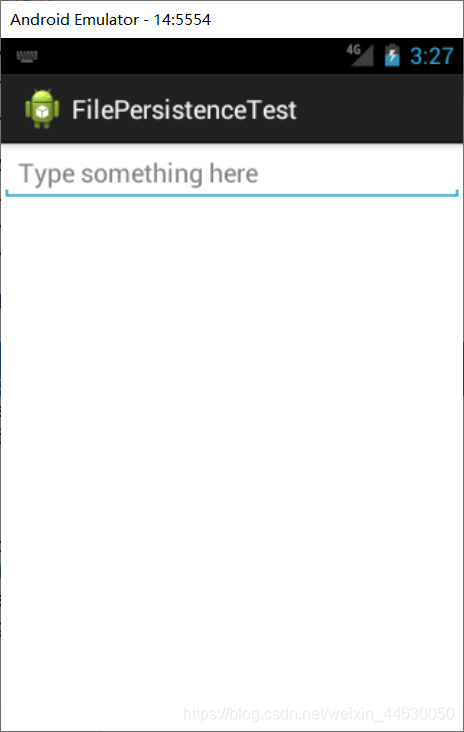一、持久化技术
- 我们平时所使用的APP产生的数据,在内存中都是瞬时的,会随着断电、关机等丢失数据,因此android系统采用了持久化技术,用于存储这些“瞬时”数据
- 持久化技术包括:文件存储、SharedPreference存储以及数据库存储,还有更复杂的SD卡内存储。
二、文件存储
- 最基本存储方式,不对存储内容进行格式化处理,适用于存储简单文本或者二进制数据,若存储一些复杂数据,那么需要定义格式规范,方便后续解析出来。
Context类提供了openFileOutput方法用于将数据存储到文件中。- 该方法接收两个参数,第一个为文件名(不可以包含路径,因为数据已经默认存储到
/data/data<packagename>/files/目录下面了。第二个参数时文件的操作模式,包括两种MODE_PRIVATE和MODE_APPEND,前一个是默认,缩写内容会覆盖。后一个表示追加内容,不存在就创建文件。 - openFileOutput()方法返回的是一个
FileOutputStream对象,得到该对象之后,可以使用流的方式写入文件。以下是一段简单的演示:
public void save(){
String data = "Data to save";
FileOutputStream out = null;
BufferedWriter writer = null;
try{
out = openFileOutput("data",Context.MODE_PRIVATE);
writer = new BufferedWrirter(new OutputStreamWriter(out));
writer.write(data);
} catch (IOException e){
e.printStackTrace();
} finally {
try{
if(writer != null){
writer.close();
}
}catch(IOException e){
e.printStackTrace();
}
}
}
- 如上就是写一个存储文件的Java流的一系列操作,如果不明白其中的含义,可以参见Java连载的流的那几期。
1.建立一个FilePersistenceTest项目用于演示
- 先修改
anctivity_main.xml文件代码
<LinearLayout xmlns:android="http://schemas.android.com/apk/res/android"
xmlns:tools="http://schemas.android.com/tools"
android:layout_width="match_parent"
android:layout_height="match_parent" >
<EditText
android:id="@+id/edit"
android:layout_width="match_parent"
android:layout_height="wrap_content"
android:hint="Type something here" />
</LinearLayout>
- 运行显示:

- 可以看到APP有一个地方可以写入文本,但是这都是临时文件,一退出就没了,因此我们需要改一下这个主xml的活动逻辑
MainActivity.java文件
package com.example.filepersistencetest;
import java.io.BufferedWriter;
import java.io.FileOutputStream;
import java.io.IOException;
import java.io.OutputStreamWriter;
import android.app.Activity;
import android.content.Context;
import android.os.Bundle;
import android.view.Menu;
import android.view.MenuItem;
import android.widget.EditText;
public class MainActivity extends Activity {
private EditText edit;
@Override
protected void onCreate(Bundle savedInstanceState) {
super.onCreate(savedInstanceState);
setContentView(R.layout.activity_main);
edit = (EditText)findViewById(R.id.edit);
}
@Override
protected void onDestroy() {
super.onDestroy();
String inputText = edit.getText().toString();
save(inputText);
}
public void save(String inputText) {
FileOutputStream out = null;
BufferedWriter writer = null;
try{
out = openFileOutput("data",Context.MODE_PRIVATE);
writer = new BufferedWriter(new OutputStreamWriter(out));
writer.write(inputText);
} catch (IOException e){
e.printStackTrace();
} finally {
try{
if(writer != null){
writer.close();
}
}catch(IOException e){
e.printStackTrace();
}
}
}
}
-
解析:我们在主活动中获取了EditText标签的文本内容,保存在了edit变量中,然后重写了onDestroy()方法,保证了在销毁这个活动的时候,能够保证内容已经保存在APP中,save方法基本和我们之前举例的一致。
-
那么如果确认我们已经保存了数据呢?

-
打开DDMS的File Explorer来查看一下,按图示打开文件
com.example.persistencetest/files/目录下面内容,并且到处,使用notepad++打开看一看,确实是我们之前输入的

2.如何从文件中读取数据
- 读取文件的函数
openFileInput()方法,用于从文件中读取数据,参数只有一个即使文件名,当然也不需要路径,因为android已经提前定义好了/data/data/<packagename>/files/目录下面,并返回一个FileInputStream对象,演示一波
public String load(){
FileInputStream in = null;
BufferReader reader = null;
StringBuilder content = new StringBuilder();
try {
in = openFileInput("data");
reader = new BufferedReader(new InputStreamReader(in));
String line = "";
while((line=reader.readLine())!=null){
content.append(line);
}
}catch(IOException e){
e.printStackTrace();
}finally{
if(reader != null){
try{
reader.close();
}catch(IOException e){
e.printStackTrace();
}
}
}
return content.toString();
}
- 上面的代码显示出一行一行的读取出文件内容。
三、源码:
- FilePersistenceTest
- 地址:https://github.com/ruigege66/Android/tree/master/FilePersistenceTest
- CSDN:https://blog.csdn.net/weixin_44630050
- 博客园:https://www.cnblogs.com/ruigege0000/
- 欢迎关注微信公众号:傅里叶变换,个人账号,仅用于技术交流



